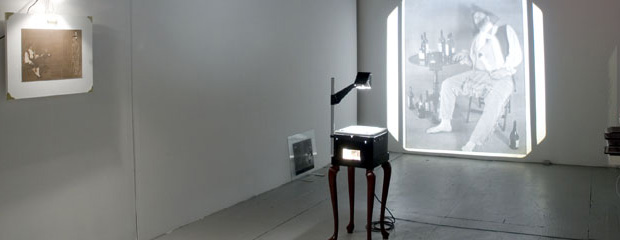|
Past exhibition
|

John Neff
Nocturnes for Boston
From: October 25 to November 29, 2008
Opening Reception: October 25, 2008 6-8pm Download Press Release (41 KB)
The solo exhibition Nocturnes for Boston, the first Boston presentation of work
by Chicago-based John Neff, is comprised of large-format toned cyanotype prints
and projected transparencies. The figurative images depict historical and recent
Boston events involving transvestism (colonists' wearing of Indian garb during
the Boston Tea Party) or masking (a study for a memorial to the 2006 death of
British citizen Adrian Exley during a breath control / BDSM session in suburban
Boston).
Since 2005, Neff has been developing a distinctive photographic method that
involves: collecting and generating digital photographic images; printing the
images as negative acetate transparencies; collaging together those
transparencies on glass to produce figurative images; and, finally, printing his
collaged negatives as cyanotype photographs. Often, Neff presents his hand-
worked negatives in conjunction with his prints.
For Nocturnes for Boston, Neff has darkened the Proof gallery space and
presents a large selection of his glass transparencies as projections from an
altered vintage overhead projector. As gallery visitors pass through the
projectors' beam, their shadows mingle with the artist's historical
reconstructions.
Neff has darkened and tinted his cyanotype prints of nocturnal Boston scenes with tea toning and multiple exposures. Although more conventionally presented,
these works also invite intimate engagement from beholders: each is accompanied
by a small chapbook outlining detailing the pictures' historical context and citing
the images' sources. Compositionally, all of the works in the show are modeled
on 18th century British "conversation pictures" and grand portraiture.
|



